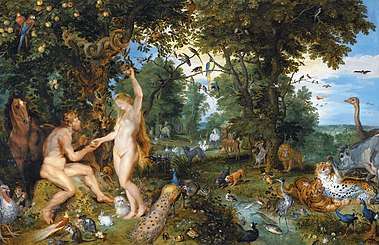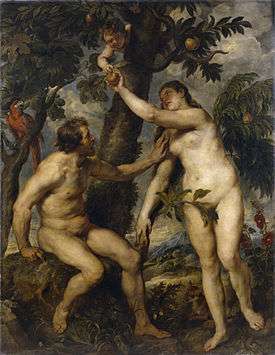Forbidden fruit

Forbidden fruit is a phrase that originates from the Book of Genesis concerning Adam and Eve in Genesis 2:16–17. In the narrative, Adam and Eve eat the fruit of knowledge of good and evil in the Garden of Eden, which they had been commanded not to do by God. As a metaphor, the phrase typically refers to any indulgence or pleasure that is considered illegal or immoral.
Biblical narrative
The narrative of the Book of Genesis places the first man and woman (Adam and Eve) in a garden where they may eat the fruit of many trees but are forbidden by God to eat from the "tree of knowledge of good and evil".
And Jehovah God commanded the man, saying, Of every tree of the garden thou mayest freely eat: but of the tree of the knowledge of good and evil, thou shalt not eat of it: for in the day that thou eatest thereof thou shalt surely die.
In Genesis 3, a serpent tempts the woman:
And the serpent said unto the woman, Ye shall not surely die: for God doth know that in the day ye eat thereof, then your eyes shall be opened, and ye shall be as God, knowing good and evil.
Desiring this wisdom, the woman eats the forbidden fruit and gives some to the man who also eats it. They become aware of their "nakedness" and make fig-leaf clothes, and hide themselves when God approaches. God curses The Serpent, The Woman then The Man, and expels the Man and Woman from the garden and thereby from eternal life.
Identifications and depictions
The word fruit appears in Hebrew as פֶּ֫רִי (pərî ). As to which fruit may have been the forbidden fruit of the Garden of Eden, possibilities include apple, grape, pomegranate,[3] fig,[4] carob,[3] etrog or citron,[3] pear, and mushrooms. The pseudepigraphic Book of Enoch describes the tree of knowledge: "It was like a species of the Tamarind tree, bearing fruit which resembled grapes extremely fine; and its fragrance extended to a considerable distance. I exclaimed, How beautiful is this tree, and how delightful is its appearance!" (1 Enoch 31:4).
An alternative view is that the forbidden fruit is metaphorical, possibly the fruit of the womb, i.e. sex and procreation from the tree of life. In his Autobiography of a Yogi, Hindu spiritual teacher Paramhansa Yogananda cites an interpretation by his master Swami Sri Yuktiswar that the Garden of Eden refers to man's body, with the fruit in the center being that of the sexual organs.[5]
Apple
In Western Europe, the fruit was often depicted as an apple. This was possibly because of a misunderstanding of – or a pun on – mălum, a native Latin noun which means evil (from the adjective malus), and mālum, another Latin noun, borrowed from Greek μῆλον, which means apple. In the Vulgate, Genesis 2:17 describes the tree as de ligno autem scientiae boni et mali : "but of the tree [literally wood ] of knowledge of good and evil" (mali here is the genitive of malum).
The larynx, specifically the laryngeal prominence that joins the thyroid cartilage, in the human throat is noticeably more prominent in males and was consequently called an Adam's apple, from a notion that it was caused by the forbidden fruit getting stuck in Adam's throat as he swallowed it.[6]
Grape
Rabbi Meir says that the fruit was a grape, made into wine.[7] The Zohar explains similarly that Noah attempted (but failed) to rectify the sin of Adam by using grape wine for holy purposes.[8][9] The midrash of Bereishit Rabah states that the fruit was grape,[10] or squeezed grapes (perhaps alluding to wine).[11]
Fig
The Bible states in the book of Genesis that Adam and Eve had made their own fig leaf clothing: "And the eyes of them both were opened, and they knew that they were naked; and they sewed fig-leaves together, and made themselves girdles".[12] Based on that reference, the forbidden fruit may have been the fig.
Rabbi Nechemia, based on the Talmud, supports the idea that the fruit was a fig, as it was from fig leaves that God made garments for Adam and Eve upon expelling them from the Garden. "By that with which they were made low were they rectified."[13]
Since the fig is a long-standing symbol of female sexuality, it enjoyed a run as a favorite understudy to the apple as the forbidden fruit during the Italian Renaissance. The most famous depiction of the fig as the forbidden fruit was painted by Michelangelo Buonarroti in his masterpiece fresco on the Sistine Chapel ceiling.[14]
Pomegranate
Proponents of the theory that the Garden of Eden was located somewhere in what is now known as the Middle East suggest that the fruit was actually a pomegranate, a plant indigenous from Iran to the Himalayas and cultivated since ancient times.[15] The association of the pomegranate with knowledge of the underworld as provided in the Ancient Greek legend of Persephone may also have given rise to an association with knowledge of the otherworld, tying-in with knowledge that is forbidden to mortals.
Wheat
Rabbi Yehuda proposes that the fruit was wheat, because "a baby does not know to call its mother and father until it tastes the taste of grain."[7]
In Hebrew, wheat is "khitah", which has been considered to be a pun on "khet", meaning "sin".[3]
Although commonly confused with a seed, in the study of botany a wheat berry is technically a simple fruit known as a caryopsis, which has the same structure as an apple. Just as an apple is a fleshy fruit that contains seeds, a grain is a dry fruit that absorbs water and contains a seed. The confusion comes from the fact that the fruit of a grass happens to have a form similar to some seeds.[16]
Mushroom
A fresco in the 13th-century Plaincourault Abbey in France depicts Adam and Eve in the Garden of Eden, flanking a Tree of Knowledge that has the appearance of a gigantic Amanita muscaria, a psychoactive mushroom.[17] Terence McKenna proposed that the forbidden fruit was a reference to psychotropic plants and fungi, specifically psilocybin mushrooms, which played a central role, he theorized, in the evolution of the human brain.[18] Earlier, in a well-documented and heavily criticized study,[19][20] John M. Allegro proposed the mushroom as the forbidden fruit.[21]
Parallel concepts
Ancient Greeks
The similarities of the story to the story of Pandora's box were identified by early Christians such as Tertullian, Origen, and Gregory of Nazianzus.[22]
Other views
Islamic tradition
According to the Quran, Surah Al-A'raf 7:19 describes Adam and his wife in Paradise where they may eat what is provided, except that they may not eat from one particular tree, should they be considered Zalimun (wrongdoers).[23] Surah Ibrahim 14:26 describes the forbidden tree as an evil tree that is forbidden for guidance.[24]
Surah Al-A'raf 7:22 describes the ˈibliːs (Satan) who misled them with deception, and then it was Adam who initiated eating from the forbidden tree. Then when they tasted of the tree, that which was hidden from them of their shame became manifest to them and they began to cover themselves with the leaves of Paradise. And their Lord called out to them: "Did I not forbid you that tree and tell you; Verily, Shaitân is an open enemy unto you?" (Quran 7:19). The Quran holds both Adam and his wife accountable for eating the forbidden fruit. As punishment, they were forced to leave the garden, banished from Heaven and sent to the Earth where they were forgiven after repenting.
See also
- Grapefruit, originally named the "forbidden fruit" of Barbados.[25]
- Apple (symbolism)
- Pomme D'Adammo
- Medieval popular Bible
References
- ↑ "Genesis Chapter 2". Retrieved 8 July 2017.
- ↑ "Genesis Chapter 3". Retrieved 8 July 2017.
- 1 2 3 4 The Straight Dope: Was the forbidden fruit in the Garden of Eden an apple?
- ↑ The Fig: its History, Culture, and Curing, Gustavus A. Eisen, Washington, Govt. print. off., 1901
- ↑ "Autobiography of a Yogi, Chapter 16, Outwitting the Stars (Paramhansa Yogananda)".
- ↑ E. Cobham Brewer (1810–1897). Dictionary of Phrase and Fable. 1898. "Adam's Apple"
- 1 2 Berachot 40a; Sanhedrin 70a.
- ↑ Zohar Noah 73a
- ↑ The Zohar: The First Ever Unabridged English Translation, with Commentary; Rabbi Michael Berg, ed., Vol. 2, pp.388-390
- ↑ Bereishit Rabah 15:7
- ↑ Bereishit Rabah 19:5
- ↑ http://biblehub.com/jps/genesis/3.htm
- ↑ Berachos 40a; Sanhedrin 70a
- ↑ High Art: Were Botticelli's Venus And Mars Stoned? : NPR
- ↑ "POMEGRANATE Fruit Facts". www.crfg.org. Retrieved 2016-11-30.
- ↑ James D. Mauseth (2014). Botany. Jones & Bartlett Publishers. p. 223. ISBN 978-1-4496-4884-8.
Perhaps the simplest of fruits are those of grasses (all cereals such as corn and wheat)...These fruits are caryopses.
- ↑ William Dudley Gray (1973). The Use of Fungi as Food and in Food Processing, Part 2. CRC Press. p. 182. ISBN 0-8493-0118-1.
- ↑ "Food Of The Gods (Terence McKenna) [FULL]". YouTube. 24 July 2011.
- ↑ "John Allegro, 65; Aided Deciphering of Dead Sea Scrolls", obit., NY Times
- ↑ John Marco Allegro: The Maverick of the Dead Sea Scrolls, by Judith Anne Brown, Wm. B. Eerdmans Publishing Company (1 March 2005), ISBN 978-0-8028-6333-1, pp. xii-xiii
- ↑ Allegro, John M. (1970). The Sacred Mushroom and The Cross: A study of the nature and origins of Christianity within the fertility cults of the ancient Near East. Garden City, New York: Doubleday. , re-released in a new edition by Gnostic Media Research & Publishing in 2009
- ↑ Charles W. Durham; Kristin A. Pruitt (eds.). "Reassembling Truth: Twenty-first-century Milton". google.co.uk. p. 37.
- ↑ Quran 7:19; "And O Adam! Dwell you and your wife in Paradise, and eat thereof as you both wish, but approach not this tree otherwise you both will be of the Zâlimûn (unjust and wrong-doers)."
- ↑ Quran 14:26: "And the simlitude/parable (مۡثَالَ )of an evil word is that of an evil tree uprooted from the surface of earth having no stability."
- ↑ Dowling, Curtis F.; Morton, Julia Frances (1987). Fruits of warm climates. Miami, FL: J.F. Morton. ISBN 0-9610184-1-0. OCLC 16947184.
External links
- Genesis 2:16–17 – English–Hebrew comparison at mechon-mamre.org
